An Improved Method for Temporary Suture Medialisation of the Middle Turbinates following Endoscopic Sinus Surgery
- PMID: 30245725
- PMCID: PMC6139232
- DOI: 10.1155/2018/9093545
An Improved Method for Temporary Suture Medialisation of the Middle Turbinates following Endoscopic Sinus Surgery
Abstract
Background: Middle turbinate (MT) lateralisation with adhesion formation (MiTLAF) is a common complication following endoscopic sinus surgery, frequently resulting in surgical failure, persistence of preoperative symptoms, and delayed secondary complications. Packing materials, splints, or spacers reduce the risk of MiTLAF but often result in postoperative nasal obstruction and discomfort, along with reduced access for irrigation. Temporary suture medialisation of the MTs reduces the risk of MiTLAF and prevents the problems encountered with packing, splints, or spacers. However, the techniques described in the literature are technically challenging and often ineffectual.
Methods: We describe a method of suture placement that provides a secure temporary MT medialisation, without the technical challenges of traditional techniques, using a 4-0 Monocryl (Poliglecaprone 25, Ethicon, Somerville, NJ, USA) suture on a 19 mm precision point reverse cutting PS-2 curved needle. We review 25 consecutive patients undergoing sinonasal procedures with our new technique and assess for MiTLAF.
Results: In our cohort, only one patient experienced MiTLAF which was not clinically significant.
Conclusions: Our method is simple, easy to perform, and highly effective and prevents adhesion formation without the need for postoperative splints or packing.
Figures
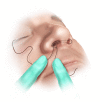

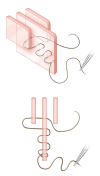
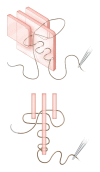
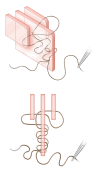
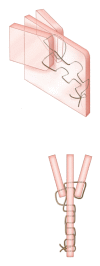
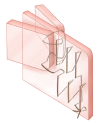
References
-
- Hewitt K. M., Orlandi R. R. Suture medialization of the middle turbinates during endoscopic sinus surgery. Ear, Nose & Throat Journal. 2008;87(12):p. E11. - PubMed
-
- Lindemann J., Keck T., Rettinger G. Septal-turbinate-suture in endonasal sinus surgery. Rhinology. 2002;40(2):92–94. - PubMed
-
- Bhalla R. K., Kaushik V., de Carpentier J. Conchopexy suture to prevent middle turbinate lateralisation and septal haematoma after endoscopic sinus surgery. Rhinology. 2005;43(2):143–145. - PubMed
LinkOut - more resources
Full Text Sources
Other Literature Sources

